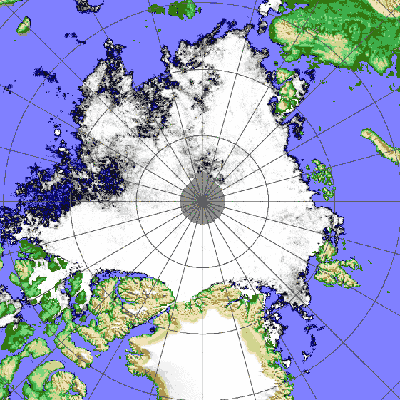 The National Snow & Ice Data Centre in the USA has declared that this year’s minimum Arctic sea ice extent has been reached – 4.52 million square kilometres on September 12th, only 390,000 km2 more than the record 2007 minimum (and 2.24 m km2 below the 1979-2000 average minimum). It looks as though their line may bump along the bottom of the graph for a while, so there may be some potential for that number to reduce a little. Their figure for Sept 12 is 9.4 percent above the 2007 minimum, so unless there’s some unprecedented melt over the next couple of weeks, I am prepared to accept that I have lost my bet with Malcolm (see comments here and at Poneke! here), which was based on NSIDC numbers. My cheque book is at the ready.
The National Snow & Ice Data Centre in the USA has declared that this year’s minimum Arctic sea ice extent has been reached – 4.52 million square kilometres on September 12th, only 390,000 km2 more than the record 2007 minimum (and 2.24 m km2 below the 1979-2000 average minimum). It looks as though their line may bump along the bottom of the graph for a while, so there may be some potential for that number to reduce a little. Their figure for Sept 12 is 9.4 percent above the 2007 minimum, so unless there’s some unprecedented melt over the next couple of weeks, I am prepared to accept that I have lost my bet with Malcolm (see comments here and at Poneke! here), which was based on NSIDC numbers. My cheque book is at the ready.
Tag: Arctic
The trumpet shall sound
 A cracking issue (#93) of New Zealand Geographic has just hit the streets – a climate change special, complete with free map of both poles. Dave Hansford looks at impacts on NZ flora and fauna, Alan Knowles examines the energy alternatives being developed here, plus there’s a range of features from around the world – including an excellent article on climate change and winemaking. I’ve got a piece in there on the long-range forecast for NZ, but the knees are not mine. I’m biased by taking the NZGeo shilling, but even so the magazine is clearly an essential part of the intellectual landscape of this country and deserves support. Well worth $14.95 of anyone’s money.
A cracking issue (#93) of New Zealand Geographic has just hit the streets – a climate change special, complete with free map of both poles. Dave Hansford looks at impacts on NZ flora and fauna, Alan Knowles examines the energy alternatives being developed here, plus there’s a range of features from around the world – including an excellent article on climate change and winemaking. I’ve got a piece in there on the long-range forecast for NZ, but the knees are not mine. I’m biased by taking the NZGeo shilling, but even so the magazine is clearly an essential part of the intellectual landscape of this country and deserves support. Well worth $14.95 of anyone’s money.
Dragging the river
 In an update to my last post on Arctic methane, I linked to a Swedish team blogging their research on the Yakov Smirnitsky, a Russian vessel currently cruising the seas to the north of Siberia. The most recent post there is fascinating, but the Google translation rather difficult to follow, so I asked Magnus Westerstrand, who first drew my attention to the blog at Eli’s place, if he could tidy up the translation. And he did, overnight. Thanks Magnus, have a schnapps on me. Here are some extracts [full text at Magnus’ blog]:
In an update to my last post on Arctic methane, I linked to a Swedish team blogging their research on the Yakov Smirnitsky, a Russian vessel currently cruising the seas to the north of Siberia. The most recent post there is fascinating, but the Google translation rather difficult to follow, so I asked Magnus Westerstrand, who first drew my attention to the blog at Eli’s place, if he could tidy up the translation. And he did, overnight. Thanks Magnus, have a schnapps on me. Here are some extracts [full text at Magnus’ blog]:
At around 110 degrees easterly longitude, when we where wrestling with drift ice in western Laptev Sea, we discovered two new areas where methane concentrations in both the water and in the air above clearly exceeded the normal methane concentration in Arctic.
The blogger, Örjan Gustafsson, then goes on to describe how the methane deposits were formed, and how the gas might now be escaping.
You ain’t seen nothing yet
 This year’s Arctic sea ice minimum is now officially the second lowest in the record according to the National Snow & Ice Data Center in the US. On August 26, the ice extent stood at 5.26m km2, dropping below 2005’s 5.32m km2. The melt season still has several weeks left to run, and there are now suggestions that this year’s final minimum could be close to – perhaps even beat – last year’s record.
This year’s Arctic sea ice minimum is now officially the second lowest in the record according to the National Snow & Ice Data Center in the US. On August 26, the ice extent stood at 5.26m km2, dropping below 2005’s 5.32m km2. The melt season still has several weeks left to run, and there are now suggestions that this year’s final minimum could be close to – perhaps even beat – last year’s record.
The NSIDC announcement has attracted a flurry of attention, and the media has been out trawling the usual suspects for quotes. The BBC reports:
Researchers say the Arctic is now at a climatic “tipping point”. “We could very well be in that quick slide downwards in terms of passing a tipping point,” said Mark Serreze, a senior scientist at the Colorado-based NSIDC. “It’s tipping now. We’re seeing it happen now,” he told the Associated Press news agency.
Adding to the interest, the European Space Agency released some interesting Envisat images of the state of the sea ice, and warned:
Following last summer’s record minimum ice cover in the Arctic, current observations from ESA’s Envisat satellite suggest that the extent of polar sea-ice may again shrink to a level very close to that of last year.
Meanwhile, Scientific American notes that the northwest passage is now open, and the Environment News Service does an admirable job of pulling all the info together – including recent work on possible rapid climate change around the Arctic. Earlier this month I was prepared to accept that I was going to lose my two bets on a new record minimum this year, so what’s been going on up north to change the outlook so dramatically?
I scare myself
 More news from the Arctic. While the German research vessel Polarstern is cruising through the Northwest Passage, the Russian Yakov Smirnitsky is touring the Siberian seas measuring methane – and the news from scientists on board is not good. Igor Semiletov of the Pacific Oceanology Institute of the Far Eastern Branch of the Russian Academy of Sciences told the Itar-Tass news agency (via Bernama):
More news from the Arctic. While the German research vessel Polarstern is cruising through the Northwest Passage, the Russian Yakov Smirnitsky is touring the Siberian seas measuring methane – and the news from scientists on board is not good. Igor Semiletov of the Pacific Oceanology Institute of the Far Eastern Branch of the Russian Academy of Sciences told the Itar-Tass news agency (via Bernama):
“Yet another POI expedition is currently at work in the Arctic, along with ours. The expedition members are exploring the Lena River mouth, where we discovered abnormally high concentrations of methane last year. POI researchers have already carried out 47 studies and confirmed as follows: the concentration of methane in water and the atmosphere increases at a rapid pace, which is indicative of the break-up of permafrost on the shelf of Arctic seas.”
Refer to my last post on the subject and the comments here for some discussion of what that might mean. It’s not good news.
[Update 28/7: I love the internet. This morning I stumbled on a link to a Swedish team working on the Yakov Smirnitsky. Their blog is well worth a visit, if only for the amusing Google translations of the Swedish originals… Hat tip to a commenter at Eli’s warren.]
[Update 31/7: Magnus at Eli’s place links to a news item on the Swedish team’s gas measurements – Google translation here…
This year’s Swedish-Russian expedition has found three new areas in western and eastern Laptev Sea where the concentration of methane is clearly increased, both in water and in the air. In addition, the scientists could measure up significantly elevated in the vicinity of Lenaflodens outflow, which Semiletov past have made similar observations.
The news gets worse.]
